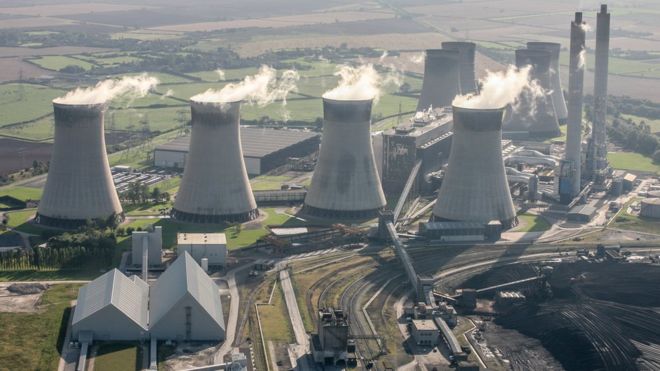
The fuel that powered the industrial revolution may be in decline at last.
This year looks set to see the largest fall in electricity production from coal on record, according to a new report.
The reduction is estimated to be more than the power generated from coal in Germany, Spain and the UK combined.
It is projected to drop by 3% – which is a fall of 300 terawatt hours.
The report by three energy experts – published in the online journal Carbon Brief – draws on energy sector data from around the world for the first seven to 10 months of the year.

The record drop raises the prospect of a slowing of global CO2 emissions growth in 2019.
But the authors warn that, even with this decline, coal use and emissions remain far higher than the level required to keep the global temperature rise below 2C.
Record decline
Coal has been the mainstay of electricity generation for over a century and has seen decades of near-uninterrupted growth.
Yet this report finds that record reductions in coal use in developed countries, including the US, European Union, and South Korea, could signal the beginning of the end of the industry.
These reductions in use are not being matched by increases elsewhere.
The decline suggests that coal plants will take a significant blow to revenues as average running hours look set to reach an all-time low.
“It is clear that the economics of coal production no longer make sense in many parts of the world where it is simply cheaper to generate electricity from natural gas and renewables,” said Bob Ward, policy director at the Grantham Research Institute on climate change and the environment at the London School of Economics.
However, he also warned that is too early to tell whether the global downturn in coal consumption in 2019 is the start of a declining trend.
Rise of renewables
The report suggests that the reasons for the drop in coal-fired generation vary from country to country, but include increased electricity generation from renewables, nuclear and gas, as well as slowing or negative demand for electricity.
In previous years the reductions in coal generation in the US and EU have been offset by increases elsewhere, particularly China.
This year, however, the fall in developed economies is accelerating, while coal generation in India and China is slowing sharply
The Chinese situation is complex.
A recent report showed a surge in new coal-fired plants in China.

However, this new analysis shows that electricity demand growth in China this year slowed to 3%, down from 6.7% over the last two years.
It finds that non-fossil energy sources – nuclear, wind and hydro generation – have met almost all of this demand.
As a result, coal-fired power plants are being used less intensively.
The report estimates that this year utilisation rates will be below 49% – a record low.
It says 2019 has also seen the first Chinese contracts for wind and solar plants that will generate power at the same price as coal power plants.
The authors say this could threaten the long-term viability of coal in China and put it on a path to renewable energy “grid parity” as those projects come online in 2020.
US bankruptcies
Meanwhile, the US has seen the largest reductions in coal-fired power generation.
This comes despite US President Donald Trump’s vigorous efforts to revive the US coal industry.
Eight US coal companies have filed for bankruptcy this year, including Murray Energy, the largest privately held coal company in the country.
At the same time, the report finds there has been a sharp turnaround in India, where coal power output is on track to fall for the first time in at least three decades.
Only south-east Asia has seen significant increases in coal generation, but demand here is relatively small relative to the global total.



